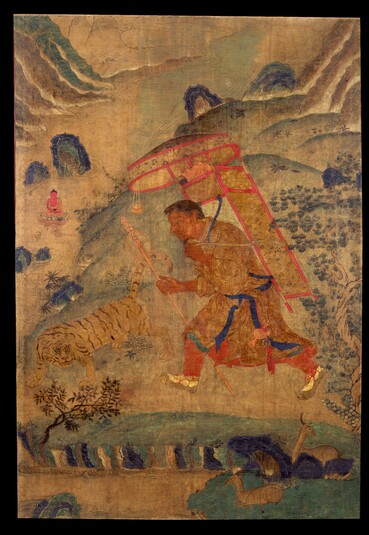
Item: Arhat/Sthavira (Buddhist Elder) - (Attendant) Dharmata
| Origin Location | Eastern Tibet |
|---|---|
| Date Range | 1500 - 1599 |
| Lineages | Uncertain |
| Size | 81.28x55.25cm (32x21.75in) |
| Material | Ground Mineral Pigment, Fine Gold Line on Cotton |
| Collection | Rubin Museum of Art |
| Catalogue # | acc.# F1997.45.1 |
| Painting School | Karma Gardri |
Classification: Person
Appearance: Arhat
Gender: Male
Dharmata, the upasaka (Tibetan: ge nyen dhar ma ta) of Central Asian or Chinese origin - the layman attendant to the Sixteen Great Arhats. (Explore this painting through an interactive series of pages).

Tibetan: Ge nyen dhar ma ta
Walking with a stoop, dark in complexion, he has short brown hair, a moustache and goatee. The right hand holds in front a monk's walking staff (Sanskrit: khakkhara) and the left grasps the strap of the carrying case at the back. With a red frame and yellow fabric covering, awkward in appearance, books are stored at the top and an incense burner hangs decoratively from the front of the circular canopy above. Dangling from the waist at the left side attached to the blue sash is a gold water flask adorned with red tassels. Wearing a dark yellow cloak with sleeves, emblazoned with gold design, the lower body attired in orange pants and yellow shoes, he strides forth with a wide gait.
"To the noble upasaka Dharmata, with the hair in a topknot and a load of books, gazing upward at Amitabha in the sky; homage to the One holding a fly-whisk and vase." (Sakya liturgical verse).
In the sky at the left seated on a trailing wisp of cloud atop a lotus blossom is buddha Amitabha, red, with one face and two hands placed in the mudra of meditation in the lap holding a black begging bowl. Below that, having emanated from the right knee of the attendant, is a large orange tiger with black stripes and yellow eyes - a protector to the Arhats. The head turned to the side gazes on two brown deer at the right with black crescent horns resting on grassy lawns amongst blue up thrusting rocks beside a quiet river. In the background the river fades and the hills ascend into mountains.
Dharmata, considered by some to be an emanation of Avalokiteshvara, belongs to a thematic set of paintings known as 'Shakyamuni Buddha and the Sixteen Great Arhats.' The full group comprises 25 figures: the buddha Shakyamuni, together with the two foremost disciples - Shariputra and Maudgalyayana, the Sixteen Arhats, the attendant Dharmata, the patron Hvashang and the Four Guardians of the Directions; Vaishravana, Virupaksha, Dritarashtra and Virudhaka. As a late addition, Dharmata was attached to the group of Arhats during the time of the Chinese Tang Emperor (9th - 10th century).
Jeff Watt 9-99
Publication: Tibetan Paintings
Publication: Worlds of Transformation
Thematic Sets
Arhat/Sthavira: Main Page & Arhat/Sthavira Appearance (Elder)
Arhat/Sthavira (Buddhist Elder) - Dharmata Masterworks
Arhat/Sthavira: Painting Masterworks (Miscellaneous)
Collection of Rubin Museum of Art: Painting Gallery 3
Arhat: Dharmata (Attendant) Main Page
Painting Set: Arhats: Single Main Figure
Collection of Rubin Museum of Art: Arhat/Sthavira
Collection of RMA: Best of Collection 2
Collection of RMA: Painting Masterworks Page
Collection of RMA: Persons Masterworks

